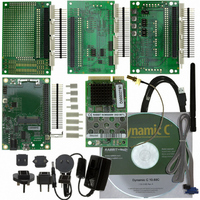101-1285 Rabbit Semiconductor, 101-1285 Datasheet - Page 68

101-1285
Manufacturer Part Number
101-1285
Description
DEV KIT DELUXE MINICORE RCM5600W
Manufacturer
Rabbit Semiconductor
Series
MiniCore™r
Type
Transceiver, 802.11 b/gr
Datasheet
1.101-1285.pdf
(130 pages)
Specifications of 101-1285
Frequency
2.4GHz
Processor To Be Evaluated
Rabbit 5000
Processor Series
RCM5600W
Interface Type
RS-232, USB, PCI
Maximum Operating Temperature
+ 55 C
Minimum Operating Temperature
- 30 C
Operating Supply Voltage
3.15 V to 3.45 V
Silicon Manufacturer
Rabbit Semiconductor
Silicon Family Name
RabbitCore
Kit Contents
Board
Features
On-board Single-Chip 802.11b/g Transceiver, Built-In Web Server
Development Tool Type
Hardware /
Rohs Compliant
Yes
For Use With/related Products
RCM5600W
Lead Free Status / RoHS Status
Not applicable / Not applicable
Other names
316-1161
6.2.5 RCM5600W Sample Programs
The following sample programs are in the Dynamic C
folder. The Interface Board must be set up as described in Section 3.2.
•
•
62
The data passed to the callback function are ephemeral since another scan may occur.
Thus, the data need to be used (or copied) during the callback function.
While waiting for user input, it is important to keep the network alive by calling
tcp_tick(NULL)
PINGLED.C
duce a long flash of LED DS1 on the Interface Board when a ping is sent, and a short
flash when a ping is received.
Before you compile and run this sample program, change
SSID
the amount of time in milliseconds between the outgoing pings.
Uncomment the
PINGLED_WPA_PSK.C
Protected Access with Pre-Shared Key). WPA is a more secure replacement for WEP.
The implementation in the sample program supports use of the TKIP (Temporal Key
Integrity Protocol) cypher suite.
The sample program uses macros to configure the access point for WPA PSK, specify
the TKIP cypher suite, assign the access point SSID, and set the passphrase.
The next macro specifies a suitable pre-shared key to use instead of the passphrase. The
key may be entered either as 64 hexadecimal digits or as an ASCII string of up to 63
characters. Authentication should be set to “open system,” which basically means that
knowing the key is sufficient to allow access.
Change
may modify
outgoing pings.
Uncomment the
#define WIFI_USE_WPA
#define IFC_WIFI_ENCRYPTION IFPARAM_WIFI_ENCR_TKIP // Define cypher suite
#define IFC_WIFI_SSID "rabbitTest"
#define IFC_WIFI_WPA_PSK_HEXSTR \
TIP: There is a good chance of typos since the key is long. First, enter the key in this
TIP: For an initial test, it may be easier to use the 64 hex digit form of the key rather than
to the host and SSID you want to ping. You may modify
sample program macro, then copy and paste it to your access point. This ensures that
both the RCM5600W and the access point have the same key.
the ASCII passphrase. A passphrase requires considerable computation effort, which
delays the startup of the sample program by about 30 seconds.
"1010101010101010101010101010101010101010101010101010101010101010"
PING_WHO
—This program demonstrates ICMP by pinging a remote host. It will pro-
PING_DELAY
VERBOSE
VERBOSE
regularly.
and
—This program demonstrates the use of WPA PSK (Wi-Fi
IFC_WIFI_SSID
define to see the incoming ping replies.
define to see the incoming ping replies.
to change the amount of time in milliseconds between the
// Bring in WPA support
to the host and SSID you want to ping. You
SAMPLES\RCM5600W\TCPIP\
PING_WHO
PING_DELAY
MiniCore RCM5600W
and
IFC_WIFI_
to change




















